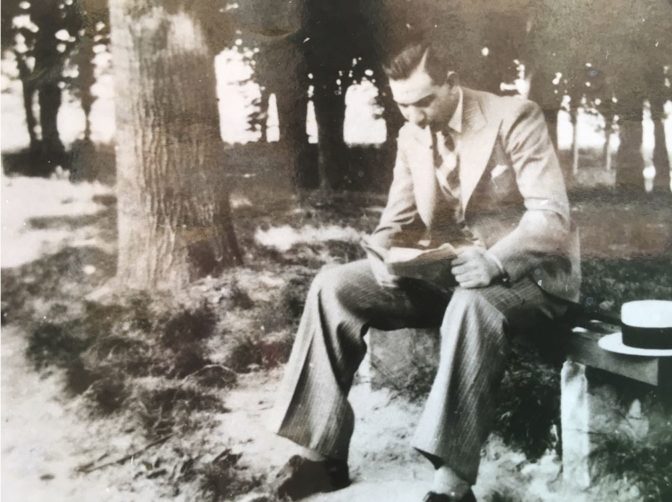Biography of Mr Marcel MICHEL (1907-1944)
Photo of Marcel Michel taken in Normandy at a property belonging to his girlfriend, Denise Marty.
Marcel Germain MICHEL was born at 11.30 a.m. on August 3, 1907, at his parents’ home at 26, rue d’Abainville in Gondrecourt, in the Meuse department of France. He was the second child of the family, his sister, Germaine, having been born in 1903.
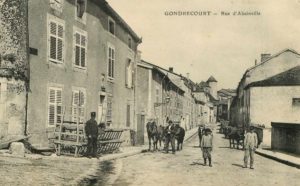
26 rue d’Abainville, Gondrecourt le Château, in the Meuse department of France, the birthplace of Marcel Michel, at the beginning of the 20th century.
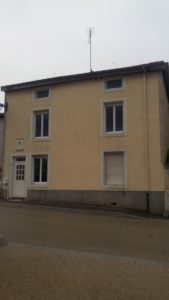
26 rue d’Abainville in Gondrecourt le Château as it is today.
Marcel’s parents
Lucien Michel, Marcel’s father, was born in the Meurthe and Moselle deparment of France, in the little village of Avrainville, in 1872. His mother, Irma Bloch, was also born in Meurthe et Moselle, at Lunéville, in 1877. There were married in 1901, in Nancy.
Lucien’s military background is as follows: he was attached to the 106th Infantry Regiment from 1893 to 1896. In the meantime, however, he was part of the Madagascar expedition of 1895, from April 6 to November 30. This war led to the annexation of Madagascar in 1897. According to his granddaughter, whom we were able to find, Lucien received a medal after jumping into the water to save a horse that had fallen off the boat and was drowning. With the outbreak of the World War I in August 1914, Lucien was called up again. He was transferred to the 138th Infantry Regiment in 1916, then to the 61st in 1917 and then to the 85th Territorial Infantry Regiment. In 1918, he joined the 5th Engineer Regiment before being demobilized on January 11, 1919, at the age of 47.
Between these two periods in the military, at the beginning of the 20th century, the Gondrecourt yearbook tells us that Lucien set up as a cattle merchant, first in association with his brother Julien, then alone. We found traces of several livestock leases in the archives at Bar le Duc. A livestock lease is a contract by which the owner of a herd, the lessor, transfers some of his animals to be kept, fed and cared for to a lessee. The lessee was entitled to half of the profits or half of any losses. Thus, in 1901, Lucien signed a livestock lease with a Mr Dourche for a cow worth 225 francs. As for Julien, his brother, he signed a livestock lease for two five-year-old cows, two calves and nine ewes worth 1,110 francs.
From 1910 onwards, the Michel family moved to the Paris area, to 14 Impasse des Chateaupieds in Rueil in the Hauts de Seine department. Then, after the floods of 1910, the family moved to 9, rue Haute. Why did they leave the Meuse? According to his granddaughter and his great-grandson, Lucien made some poor business deals. He put all of his money into buying horses, which all became ill and died. The couple was therefore ruined. Lucien was then hired at the Arsenal de Rueil, which included artillery and tank assembly and repair workshops during the First World War.
The couple arrived in Rueil, which had become Rueil Malmaison in 1928, with two children, Germaine and Marcel. They were to have two other daughters: Yvonne born on January 31, 1912 and Renée Clémentine born on August 7, 1914.
Irma, Marcel Germain’s mother, remained a stay-at-home mother and raised all her daughters’ children, two boys and two girls, whose birth and/or death certificates we were able to find. The niece also told us that her grandmother Irma had falsified her birth name during the Second World War, in 1940, in order to hide her Jewish ancestry: her surname Bloch thus became Blochet.
Marcel Germain Michel
In his military service record, Marcel Michel is described as a man of 5’9” in height with a matt complexion, light brown hair, an oval face with green eyes, a small forehead, a protruding chin, a large nose and thick lips. It is also noted that he had an education level of 3, meaning that he had “a more advanced primary education”.
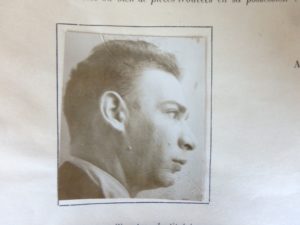
An anthropometric photo of Marcel MICHEL related to his status as a fairground worker
Marcel’s military past
Marcel Michel was from class 27, registration number 5354. He carried out his military service with the 129th regiment of heavy horse-drawn artillery starting on November 14, 1927. The Langres reform commission then temporarily discharged him on 16 December 1927 for medical reasons. He suffered from a hydrocele and underwent an operation as a civilian. He returned to the regiment, as a second gunner, on December 18, 1928. He was hospitalized again in the military hospital at Chaumont from December 18 to 22, 1929. He was held in custody as a disciplinary measure for 25 days and then sent back to his billet on April 19, 1930. He was issued with a certificate of good conduct.
When World War II broke out, there was a large-scale mobilization. On 18 October 1939 Marcel was posted to the artillery mobilisation center 341 in Fontainebleau. Then, on 30 December 1939, he was assigned to the depot of the 22nd BOA, a Battalion of Artillery Workers, at Vincennes. The battalion was not intended to go to the front, this being an interior war depot.
Marcel Michel’s military record also mentions a few run-ins with the law: on July 28, 1926, the Seine Correctional Court first sentenced him to a 15-day suspended prison sentence for insult and assault against a citizen appointed by a public service department. Then, on April 12, 1927, the same court sentenced him to a fine of 25 francs for “insulting an officer”.
Marcel’s work history
Marcel’s military record mentions the profession of slate worker in 1927, when he and his family were living at 9, rue Haute, in Rueil.
A little later, the Prefecture of Police in Paris noted that a travelling salesman’s identity card was issued to Mr Marcel Michel in 1932 and 1933. By this time, he was living at 9, avenue de Taillebourg in the 11th district of Paris.
A decree dated July 16, 1912 brought in new regulations for itinerant tradespeople and the movement of travellers. They were divided into three categories: travelling salespeople, fairground workers and stallholders and finally travellers, or nomads. This law required travelling salespeople to declare their activity to the prefecture, while fairground stallholders had to carry an identity card and travellers, i.e. non-settled people who did not fall into either of the previous categories, had to carry an individual anthropometric card which had to be stamped in each municipality in which they stayed.
For the Fallières government, the aim was to control illegal movement of people, by registering most of those regularly present on the roads.
Health and hygiene appeared to be an important part of this control of the “non-sedentary” population. Indeed, the law of 1912 subjected these people to a whole series of special measures concerning smallpox vaccination and general prophylactic treatment. Applicants were required to provide a certificate stating that they had been successfully vaccinated or revaccinated against smallpox within the past ten years. In addition, the decree of May 3, 1913, made provision for the mayor of the municipality to have the health of the fairground worker or traveller, along with those accompanying him, checked upon arrival in his community. He could also have vehicles and caravans inspected to ensure compliance with health regulations (source: https://francearchives.fr).
We were not able to find Marcel Michel’s fairground worker’s identity record but we were able to obtain, thanks to Mr Nomdedeu, a volunteer at the Fil d’Ariane Association, a copy of the identity record of Fernande Duperriet, a fairground dealer in 1933. (see appendix carnet identité forainain). In the pages of this document, one can see the penalties applicable in the event of failure to make a declaration at the prefecture and to present the said record book, which include fines and even imprisonment. Identity photographs were also regulated: for fairground stallholders, they had to “be in profile (right side) and have a dimension of 3 to 4 centimeters (1.2 to 1.6 inches), measured from the hairline to the tip of the chin “. One can see on the photograph above that Marcel Michel was indeed photographed from the right, according to the Prefecture’s instructions.
Later on, in February 1938, we find Marcel Michel listed in the commercial register as a market trader selling goods from Paris. He was then living at 58 rue de Buzenval, in the Charonne area of the 20th district of Paris. His niece confided to us that Marcel “sold on the fly; he could be sellling bananas one day and porcelain the next”. His job allowed him to travel a great deal throughout France and, since he loved children, he often brought back trinkets for his nieces and nephews.
Marcel Michel’s business activity records from 1938
Marcel himself never had children of his own. He had a girlfriend named Denise Marty with whom he lived at 40, rue de Picpus in the 12th district of Paris. She owned a property and some horses in Normandy and Marcel, who was very fond of horses, used to go there quite often. Lucien’s niece sent us a very beautiful photograph of Marcel taken at this property. The picture shows a man very elegantly dressed in a suit and tie and wearing a boater.
Marcel’s arrest, in 1942, and his subsequent escape
We did not find out where or how Marcel Michel was arrested in 1942, but we discovered that he was interned in the Drancy camp on November 14, 1942. He was in possession of a rather substantial sum of money, 2900 francs, which was handed over, by mandate, to Miss Marty on December 9, 1942. These documents also tell us that Michel was interned in Block V, stairway 20, room 9 at the Cité de la Muette. The students of the Zola high school were able to locate this room on the model exhibited at the Drancy camp site.
.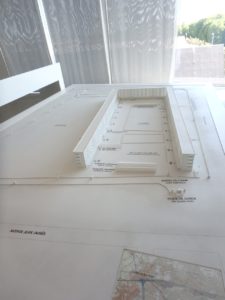
Photo of the model of the internment camp at Drancy
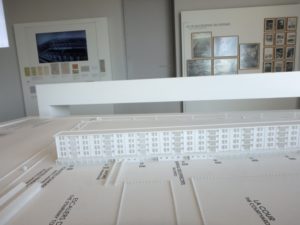
Photo of the model of the internment camp at Drancy, showing the building where Marcel Michel was held in 1942, before his escape.
The Drancy records also reveal that Marcel Michel escaped from the camp on December 17, a little more than a month after his arrest. In a letter sent to me by his niece, we are told that he escaped through the sewers, although according to the tour guide at Drancy, he must have been assigned to work outside the camp at the time of his escape. The street names shown in the sewers enabled him to reach his aunt Yvonne’s house in Vincennes. He was in a sorry state when he arrived. A neighbour saw him and although she visited regularly, she said nothing. “This still happened occasionally,” as Lucien’s niece told us.
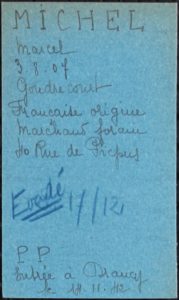
Record card of Marcel Michel’s initial internment in 1942, with a note saying ‘escaped’.
In a report about the Drancy internment camp of December 1942 originating from the Prefecture of Police, we find that at that time, the total number of detainees in the camp was 3031. The movement records reveal that of the 926 people arrested in December, 148 were released and 86 were readmitted, including 1 escapee who had been recaptured. On the following page of this report, we can see that there were 3 escapees in December 1942; Marcel was among them.
In the subsequent report, for the months of January and February 1943, we discover the appalling conditions experienced by these men and women in the Drancy camp: insufficient daily rations, 350 people destitute because of a lack of clothing, rooms infested with lice and bedbugs which led to an increase in the number of people with lice and mange, bedding in poor condition. And what can we say about this remark made by the commander of the internment camp and addressed to the Director of Administrative Affairs of the General Police, dated 28 October 1942: “[The members of] this transient population, knowing that they are to be sent to an unknown destination, have, or are acquiring, a deplorable mentality. They ruin, soil or steal the objects placed at their disposal”?!
Marcel’s arrest, in 1944, and his deportation
Marcel Michel was arrested again on July 13, 1944. Although he was then resident at 40, rue de Picpus in the 12th district of Paris, several documents mention “Moneiville” or “Mondeville” in Calvados, which in the Normandy department in the north west of France, as the place of arrest. Was he passing through and staying at the Denise Marty’s place? The sum recovered from him and shown on the Drancy camp internment sheet, 6,507 francs, could also lead us to believe that he was in Normandy for his work. Was he arrested when he was selling his goods at a market in Mondeville? Research carried out in the local and departmental archives did not yield any further information about this arrest. As for the family, they thought he was arrested in a bar near his Parisian home.
In any event, Marcel Michel was interned for a second time at Drancy on July 15, 1944 with the serial number 25190. A card written in German tells us that he was deported to the Auschwitz concentration and extermination camp on July 31, 1944. This card gives the name and address of Marcel Michel, the date and place of birth and bears the word “Jew”. This convoy bore the number 77, it was the last large convoy from Drancy to Auschwitz. It carried more than 1300 deportees: 726 were gassed on arrival, 291 men and 183 women were selected for work at Auschwitz and only 93 men and 157 women in this convoy survived this hell until 1945.
The records held by the Division of the Archives of Victims of Contemporary Conflicts in Caen, Normandy, show that Marcel died on the journey, although a judgment of the Seine court, dated November 10, 1949 officially recorded his death as having taken place on August 5, 1944 in the Auschwitz camp. This judgment was included in the civil status registers of the town hall of the 12th district of Paris on April 24, 1947.
The title of “Death by deportation” was granted to Michel Marcel by order of the Minister of Veterans and Victims of War dated 6 July 1995, and published in the French Official Journal of 6 September 1995.
This biography was written by the CAP (certificate of professional competence) students in multi-specialty commerce at the Lycée Professionnel Emile Zola, a high school in Bar Le Duc in the Meuse department of France, along with their history and geography teacher, Madame Schweizer.
This research and collecting the documents was only possible thanks to :
* M. Stéphane MARTIN, maire de Gondrecourt le Château (55)
* Mme DELABY, archives départementales de Bar le Duc (55)
* Archives municipales de Lunéville (54)
* Archives municipales de Nancy (54)
* Mme Clémence LEON, archives départementales du Val de Marne (94)
* M. Dominique Le Boeuf, archives départementales des Yvelines (78)
* Mme Lihourquet-Dujardin de la mairie de Rueil Malmaison (92)
* Les archives départementales des Hauts de Seine (92)
* Les archives de Paris (75)
* Mairie du 12ème arrondissement de Paris
* Archives départementales du Gard
* Mme Myriam Angevin, adjointe déléguée à la culture et au patrimoine d’Aigues Vives (30)
* Division des archives des victimes des conflits contemporains à Caen (14)
* Mairie de Mondeville (14)
* Archives départementales du Calvados (14)
* Les personnes bénévoles de l’association Fil d’Ariane : Mmes Leblois, Douroux, Pechon, M. Angella et plus particulièrement M. Nomdedeu qui a fourni un travail de recherche considérable aux quatre coins de Paris.
We are particularly grateful to all these people who collaborated actively to our research throughout France and thus made easier our collecting these official documents.
Thanks also to :
* M. Parisot et M. Fournier du Souvenir français, comité cantonal de Bar le Duc
* Le Ministère des Armées, direction des patrimoines, de la mémoire et des archives
Thanks to the subsidies received, the CAP class of Emile Zola high school could travel to and visit the Drancy internment camp and discover this place, so important in the History of the Second World War and in the personal history of Mr Marcel MICHEL.
Michel MARCEL 1942 family photo collection
Marcel MICHEL GONDRECOURT debut XXeme
Marcel MICHEL maison familiale GONDRECOURT en 2019
Marcel MICHEL photo anthropometrique forain
OLYMPUS DIGITAL CAMERA
Marcel MICHEL maquette DRANCY ensemble
Marcel MICHEL maquette DRANCY batiment internement 1942
F/9/5716
fiche-transport-convoi-77-jpeg
Marcel MICHEL arbre genealogique z
Our warm thanks also to :
* M. Parisot and M. Fournier from the Souvenir français, comité cantonal of Bar le Duc
* The Ministry of Defense, direction des patrimoines, de la mémoire et des archives
Thanks to the subsidies received, our class of Emile Zola CAP visited the internment camp of Drancy and dicovered this place of Remembrance, unique in the WW II and in the history of Mr Marcel MICHEL.


 Français
Français Polski
Polski